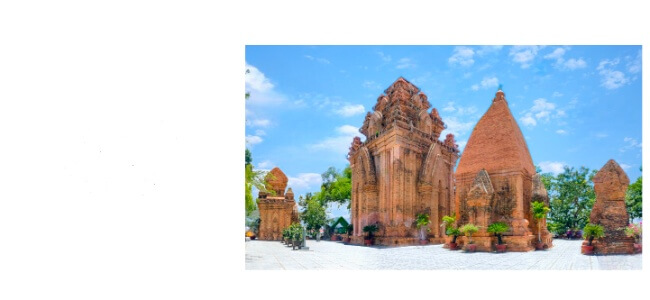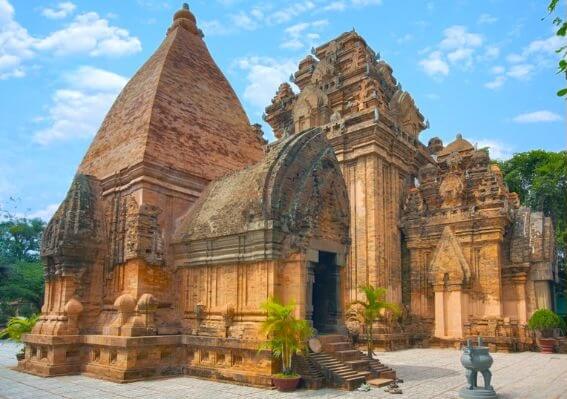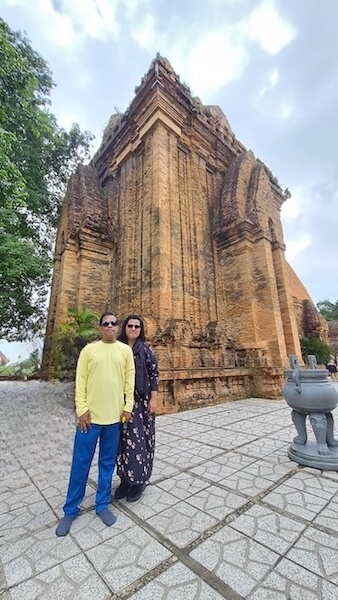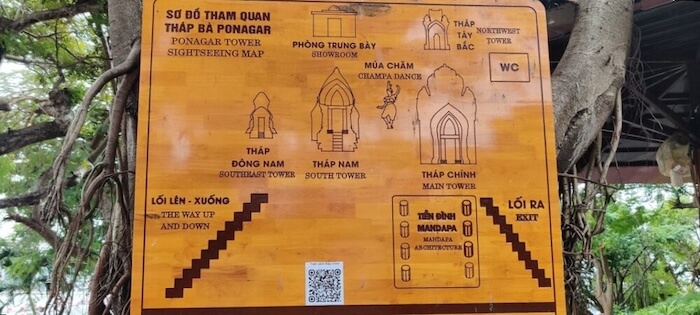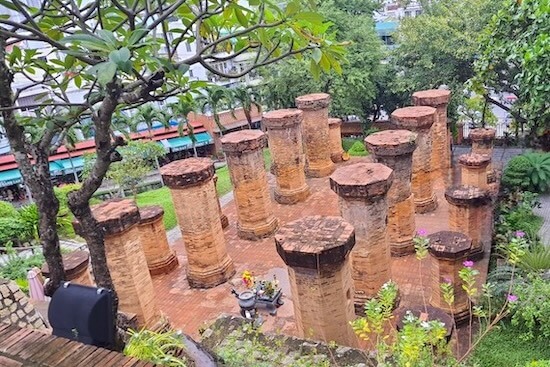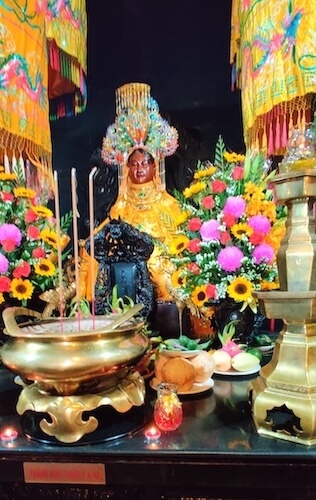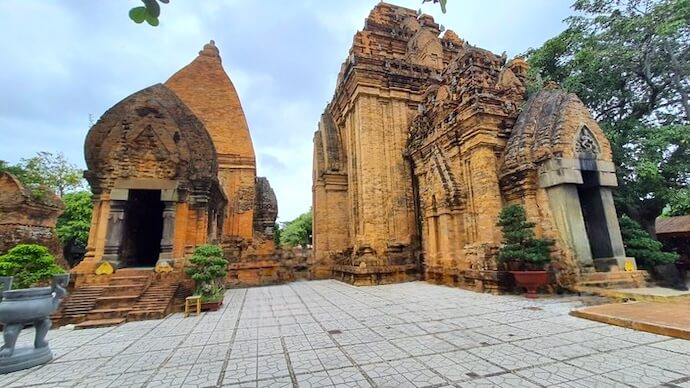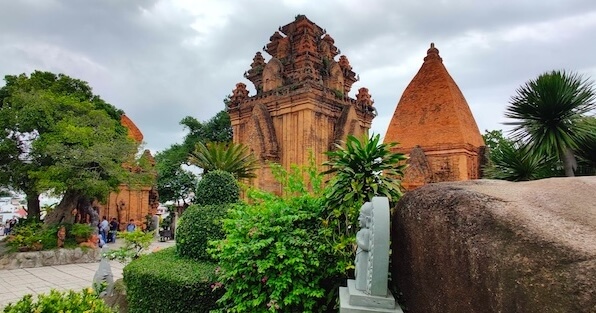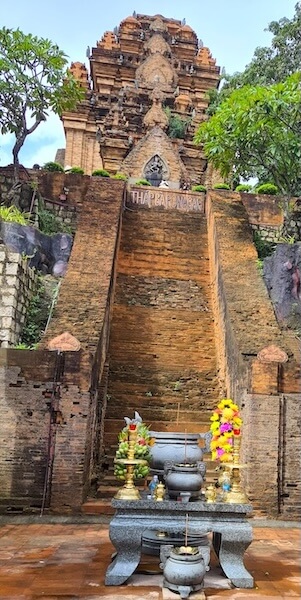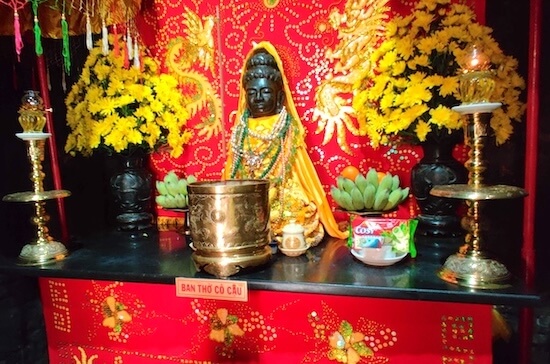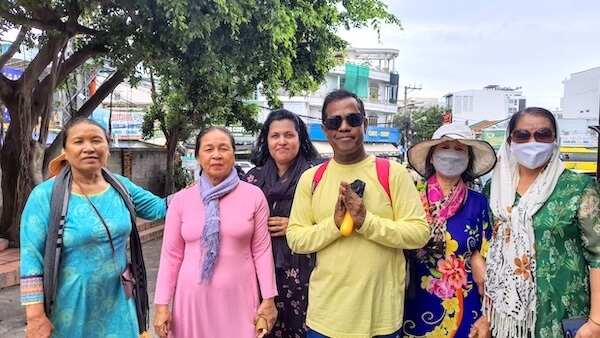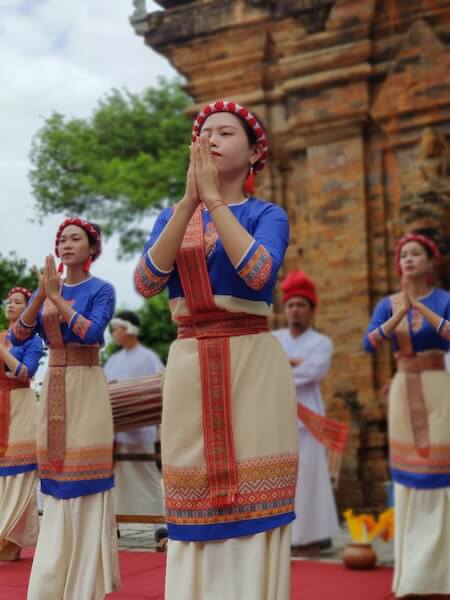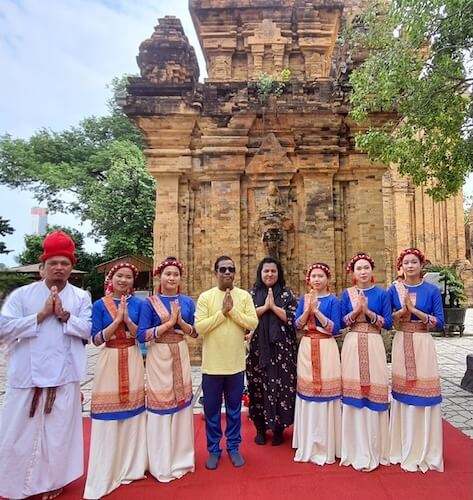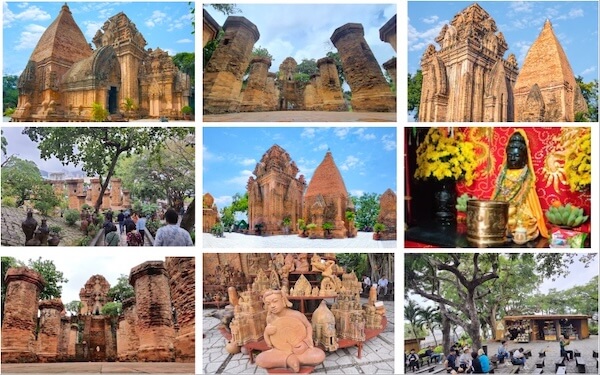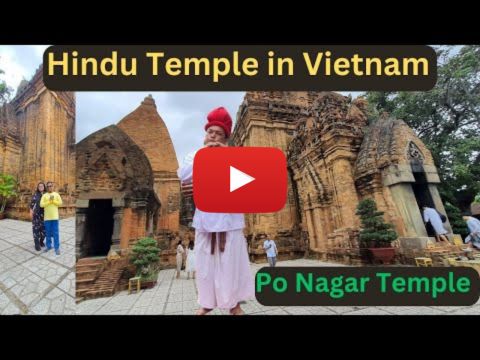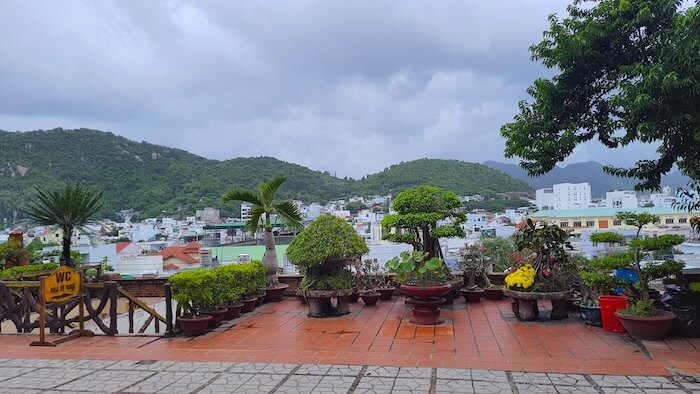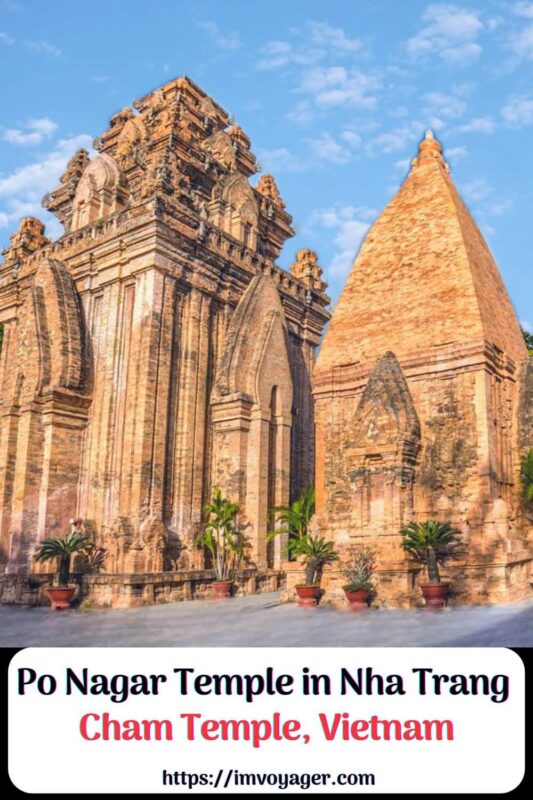“This is the famous Po Nagar Temple, an important landmark of my hometown, Nha Trang,” said our guide Tum, his eyes gleaming with pride. Of course, Tum was an alias for foreigners who could not pronounce his Vietnamese name, Nguyen Thanh Tung. After a couple of days in Hanoi, including a day cruise on Halong Bay as part of our Vietnam itinerary, we were in the coastal city of Nha Trang. We had begun our exploration of Nha Trang with a visit to Ponagar Cham Tower. We spent a couple of hours exploring the ancient Thap Ba, or Ponagar temple, located on a small hill known as Cu Lao Hill, not far from the Cai River.
Table of Contents
Hindu Temple In Vietnam – Po Nagar Cham Towers Nha Trang
The historical influence of Indian culture and religion on Southeast Asia comes alive in the Po Nagar Temple in Nha Trang, Vietnam. During our travels across Cambodia, Thailand, Malaysia, and Vietnam, we have been fascinated by the extent of India’s cultural and historical influence and its impact that can still be found in these cultures.
It was a pleasant surprise when we visited the seaside Vietnamese city of Nha Trang. The city, with its resorts, casinos, and nightclubs, was actually the medieval principality of Kauthara, a part of the Champa Kingdom, which came into existence in the second century. The Po Nagar Cham Towers stand defying the forces of nature and time, a silent witness to the region’s history from its inception, which is believed to be before the mid-8th century.
Visiting Po Nagar Temple | Po Nagar Cham Tower
We visited the Vietnam Temple Po Nagar, originally a Hindu temple, but now a temple in which both Buddhists and the minority Hindus among the Cham community worship. It is a Cham temple, which means it was built by the Cham rulers who were primarily Hindus. Later on, the inhabitants of the medieval Hindu Kingdom of Champa, known as Chams, started following Islam. Today, the majority of the Cham community is Muslim, while a small minority is Hindu.
Our effervescent guide secured the entry tickets to the temple, and we entered the complex that housed the Ponagar Tower. The Po Nagar Temple complex has three levels. A series of steps led to the top of the hillock on which the main tower or main temple of the Po Nagar temple complex was situated. Three smaller towers surrounded the main tower, one in the northeast direction, one in the southern direction, and another in the south-eastern direction.
However, we learned that originally the complex had 6 towers, of which 2 have collapsed, and their foundation can still be seen. Today, there are a total of 4 towers, including the main tower.
On a lower level, facing the main tower, we found intriguing-looking rows of columns, whose purpose was not clear. It is not known whether they were pillars that had supported a structure that had now been destroyed. These magnificent brick columns reminded us of the columns that adorned ancient Rome.
According to researchers, the columns are part of what must have once been a covered building where devotees gathered, before proceeding to the main tower. The fact that a board in the Po Nagar temple referred to this cluster of columns as “Mandapa” also lent credence to this conjecture. In Hindu temple architecture, Mandapa is a term used for a hall located between the entrance and the sanctum of a temple, where visitors gather.
From the Mandapa area, there is an unobstructed view of the main tower at the top. The facade of the main tower seemed similar to some of the temples of Siem Reap in Cambodia, particularly the Banteay Sreai temple. Another fascinating fact that we discovered was a series of almost vertical steps behind the Mandapa area that led straight up to the main tower. These steps are not in use today, but they reminded us of the steps that led to the main Ayappa temple in Sabarimala.
After spending some time appreciating the magnificent pillars that must have once supported a closed structure, we climbed a few steps to the top level. We paused for some moments to look at the stunning view of the Cai River and the city of Nha Trang stretching out before us. We then made our way to the top of the hill.
We first visited the subsidiary towers, which are smaller than the main tower. These were temples to Skanda, also known as Subrahmanya or Kartikeya, the son of Shiva and Parvati; a temple to Ganesha; a temple to Shiva. Though these were originally Hindu deities, they have been influenced by Buddhism, and later Vietnamese culture, so Ganesha did not have an elephant head, also, the rituals and rites of worship are different. However, you can find Hindu motifs like a Shiva Linga and a Mahishasuramardini.
It may be worth mentioning here that the Cham Hindus practice a religion that has evolved from Hinduism, and they are known as Balamon Cham Hindus. It is believed that etymologically, Balamon has evolved from Brahmin, and the Balamon Hindus are the priests who conduct the worship at the temples. The religion that they practise is Shaivite Hinduism.
Main Tower of Po Nagar Temple | Thap Ba
Po Nagar Temple Nha Trang | Cham Temple of Vietnam
The main deity at the Po Nagar temple is the Mother Goddess. The beautiful idol of the Goddess with a benevolent and serene expression greeted us as we entered the sanctum. She was dressed in a beautiful gown and wore ornaments, and a glittering crown adorned her head. Colourful Chinese lanterns hung on either side of the deity, and colourful bouquets were placed before her. The sanctum was pervaded with the fragrance of incense sticks that burned before the deity. Two smaller idols were placed against the left side wall of the sanctum. We circumambulated the idol of the Goddess and, after prostrating ourselves in front of her, slowly emerged from the sanctum sanctorum of the Po Nagar temple.
The idol was fully covered with robes, barring her face, which glowed with a divine radiance and had a dark brown colour. However, we checked online for further details and what the idol looked like. We surmised that the idol measured around 90 cm and was seated in Padmasana. Her right hand was lifted in the abhaya mudra while her left hand showed the Varada mudra. In addition, she had eight other hands, four on either side holding various weapons and other items common in Hindu symbology. These included a sword, spear, club, arrow, bell, conch, bow, and shield.
Our Guide informed us that she was worshipped as Uma, the consort of Shiva, by the Cham Hindus. Later research revealed fascinating information about the deity. It is believed that originally the Goddess was worshipped as Parvati or Mahishasuramardini. The influence of Buddhism gave her the names of Bhagawati and Hariti, and later, sometime in the 17th century, the Goddess was identified by the Vietnamese as the Mother Goddess Po Nagar or Yan Po Nagar. Another Vietnamese name for the Goddess is Thiên Y Thánh Mẫu.
Whatever the religious affiliation of the Goddess or her name, it was clear that she was a benevolent Mother Goddess, who showered her devotees with prosperity and well-being, the female or Shakti aspect of divinity in Hinduism.
The Legend of Lady Po Nagar or Yan Po Nagar
Legend has it that Po Nagar was the founder of the Cham religion. The Cham people believe that they originated from Lady Po Nagar. According to mythological belief, Po Nagar was born from the clouds in the sky and the foam in the sea. She manifested herself on a piece of Agarwood floating in the ocean. She is believed to have had 97 husbands and 39 daughters who were also forms of divinity. The Champa people believe that the Goddess Po Nagar created the world, Agarwood or Eaglewood from which incense sticks are made, and rice. Po Nagar is considered a Goddess of nature, plants, and trees, a benevolent divinity who showered blessings on her devotees.
Po Nagar Temple History | Ponagar Temple
We were so fascinated by the Goddess Po Nagar and her similarity to the Devis of Mother Goddesses of Hinduism, that we did a little bit of secondary research on her and the history of the Po Nagar temple, and here is the chequered history of the Po Nagar temple in brief.
The origins of the temple are not known; the earliest historical mention of the temple was found in an inscription on a stele that was dated 781. The inscription mentions that a Champa king named Satyavarman had rebuilt and restored the temple. This leads to the conclusion that the Po Nagar Temple existed before this period and must have been destroyed by invaders earlier in history.
Other steles at the site also talk about the existence of a Mukhalinga, which is a Linga with one or more faces carved on it. This Mukhalinga, which was decorated with precious stones and jewellery, was destroyed by invaders from the sea, who took away the jewellery with them. The king, however, restored the Mukhalinga in the year 784. Inscriptions also talk about grants to the temple by successive Cham kings like Harivarman I and Vikrantavarman III.
Another important chapter in the history of the Po Nagar temple unfolded in the year 918, according to a stele installed by the Cham king Indravarman III. The stele mentions the installation of a golden idol of the Goddess Bhagavathi at the Thap Ba temple that we now know as Po Nagar temple. This is what the stele says, according to Prof. Dr. Ngo Vaan Daanh:
“In the year of the Sakas denoted by ‘vyoma-amburasi-tanu’ [840 Saka], on Sunday, the eleventh day of the dark fortnight of the month of Suci [Jyaistha or Asadha], he [Indravarman III] installed a golden image of the goddess Bhagavati in order to gain fame around the whole world.”
The stele also incorporates attributes of Indravarman III and sings his praise:
King Sri Indravarman, skilful in protecting Champa, was like a full moon in the sky. He who [skifully played in the] good waves that are the six systems of Philosophy beginning with Mimamsa and those of Jinendra, and in the mass of water which was [Panini’s] grammar with Kasika, who was a fish [in the water] which was the Akhyaca and the Uttarakalpa of the Saivas; because among the learned, he was the most skilful in all these subjects.
However, evil forces from across the sea had their eyes on the prosperous Po Nagar temple. Another stele inscription by Jaya Indravarman I informs that the golden statue was carried away by the Kambujas and destroyed. Here, the reference is to the forces of the Khmer king Rajendravarman II, and this is validated by inscriptions of Rajendravarman II himself, which have been found in Cambodia, that talk about his conquest of the Champa kingdom.
The Champa Kings must have regained power within a short time, as the stele of Jaya Indravarman I proves. His inscription also tells that he installed a stone statue of Bhagavathi in Kauthara (present-day Nha Trang).
Whether the existing stone statue is the same as the one installed by Jaya Indravarman I in the year 965 is not known, and there are diverse opinions on this among historians. Other steles dated to the 11th century speak about endowments by different kings, notable among them being a Shivalinga by Jaya Indravarman III in the year 111. Another later stele talks about the Khmer king Jayavarman VII invading Champa and carrying off all the lingas with him to what is now Cambodia.
Some later inscriptions point towards the emergence of a cult that worshipped the Goddess as Yan Po Nagar, they also talk about statues of Buddhist divinities.
It was sometime in the 17th century that the Vietnamese took over the region of Champa, and they made the Goddess of Po Nagar Temple their own, and called it Thiên Y Thánh Mâu Tower.
Vietnamese Champa Architecture At Po Nagar Temple, Vietnam
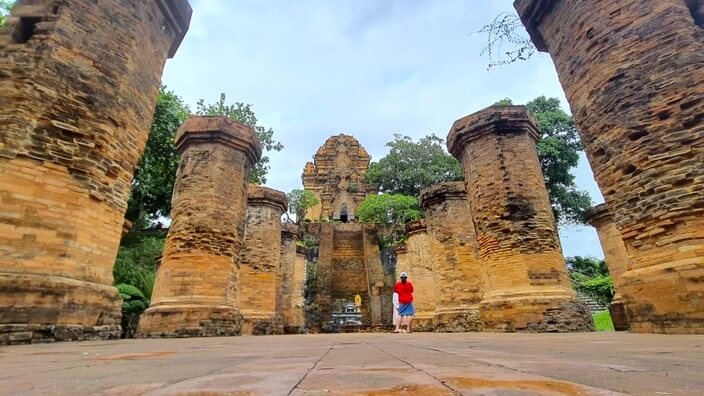
The structures in the Po Nagar Temple complex have a lot of similarities with the temples of Cambodia. Of course, the influence of Indian temple architecture cannot be underlined enough. The temple is laid out on three levels, with the main tower and subsidiary towers at the top. The level below it must have been some sort of a hall or pavilion, for devotees to gather before ascending to the main temple through a flight of steep stairs.
These steps are similar to those found in many temples in Cambodia, including Angkor Wat.

An arched entrance with a turnstile provides entry into the Po Nagar Temple complex. At the ground or first level can be found counters where you can buy offerings for the deity. There are also some shops here that sell local handicrafts. A showroom of handicrafts is also located on the top level.
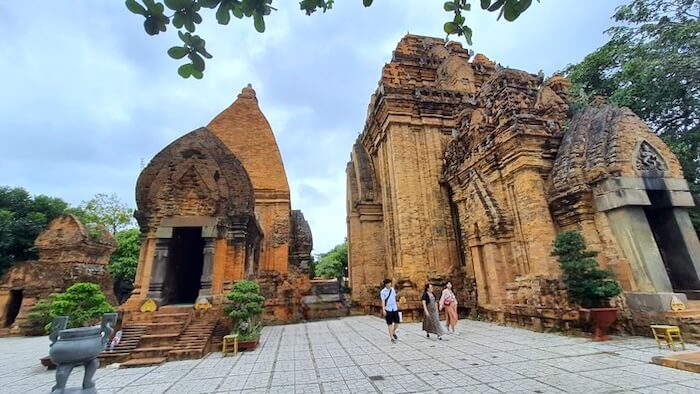
The temples are topped with ornamented shikhara-like structures. The ornamentation has worn away with time, and only some vestiges remain. Noteworthy among these is a carving of Durga as Mahishasuramardini on a pediment above the entrance to the main temple.
In all 4 temples or towers, access to the sanctum or Garbagriha is through a very narrow vestibule. The entrance to the tower is quite small, and only a single person can enter the door at a time. The temple in its heyday must have been truly magnificent, but even in its present avatar, it emits an aura of grandeur. The mysterious columns on the second level are what catch the eye as soon as you step into the Po Nagar temple complex.
Talking To The Cham Priest Of Po Nagar Cham Tower
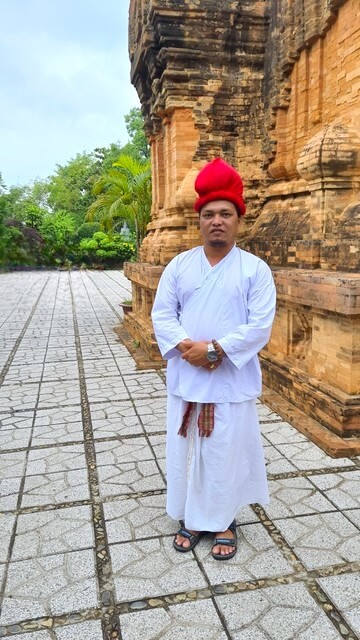
He was dressed in white robes, and what looked like a red turban adorned his head. He wore a bracelet made of what looked like Rudraksha beads on his left wrist. His name was Ky, and he was the priest of the Po Nagar temple. We spoke to him and asked him about the religious practices and customs of the Cham people. He was very erudite and replied to our questions with great alacrity, though we could not make head or tail of it, as he spoke in the local language. Our guide turned interpreter and facilitated the discussion. Here is the gist of our discussion with the Cham priest of Po Nagar temple in Nha Trang, Vietnam.
The first thing Ky, the Cham priest, said as soon as he learned that we were from India was that the current Indian government was very supportive of the Cham people.
He then talked about the Balmon Hinduism that he followed. He said that their death rites were similar to those of the Hindus. He mentioned that they cremated the dead, and later collected the ashes and asthi from the cremation site, and immersed them in the river. We learned that though they did eat non-vegetarian food, there were periods during which they abstained. They also never ate beef, as they considered the Cow sacred.
He also mentioned some of the deities that they worshipped, and these included Ganesh, Shiva, Skanda, Vishnu, Garuda, Indra, and Varuni. The priest also recited a prayer for our benefit.
On our way back, we also happened to meet a few Cham ladies who were on their way to pray at the Po Nagar temple.
Cham Dance Ponagar Temple Nha Trang
In a courtyard between the four towers that house the main temple and the smaller temples in the Ponagar temple complex, visitors can witness a graceful Cham dance performance. We were lucky to witness the dance in close quarters. This was a traditional dance of the Cham people, not to be confused with the Buddhist Cham dance, which is usually done by monks wearing masks. In this dance of the Cham people, women dancers dressed in traditional attire moved gracefully to the music of drums. The fluid dance moments were similar to the dance moves of the Apsara dance that we had witnessed during our Cambodia visit.
Thap Ba Festival, Po Nagar Temple
An annual festival known as the Thap Ba Festival takes place within the Po Nagar Temple complex. The festival is organised from the 20th to the 23rd of the third month of the Lunar year. The festival is dedicated to the presiding deity of the temple, Po Nagar. One of the important rituals of the festival is the changing of the costume and headgear of the idol of the Goddess, after washing it with a fragrant lotion made from leaves. The Goddess is then worshipped, and devotees pray for her blessings. Various programmes of dance and music, particularly the Ball Dance of the Cham people, are organised during the festival. A boat race is also held during the festival.
Po Nagar Cham Towers Photos
Here are some images of the Cham Temple Tower and other interesting sights that we saw as we explored the Po Nagar Cham Temple Complex.
Video of Po Nagar Temple in Nha Trang, Vietnam
How To Get To Po Nagar Temple
The Po Nagar Temple is a Cham temple, a Hindu temple in Vietnam located in the city of Nha Trang in central Vietnam. It is located near the Cai River and is about 4 kilometres from downtown Nha Trang, and can be reached by a 10-minute drive.
- Nha Trang is at a distance of about 1,289 kilometres from Vietnam’s capital, Hanoi
- Ho Chi Minh City is at a distance of about 408 kilometres from Nha Trang
- Da Nang is about 525 kilometres from Nha Trang
- Nha Trang is served by the Cam Ranh International Airport, which is at a distance of about 36 kilometres from downtown Nha Trang
- You can fly to Nha Trang from Hanoi or Ho Chi Minh City
If you are planning a trip to Vietnam, you can book your flight to Hanoi or Ho Chi Minh City right here through Air India (Domestic) or Air India (International), or Priceline .
Where To Stay In Nha Trang
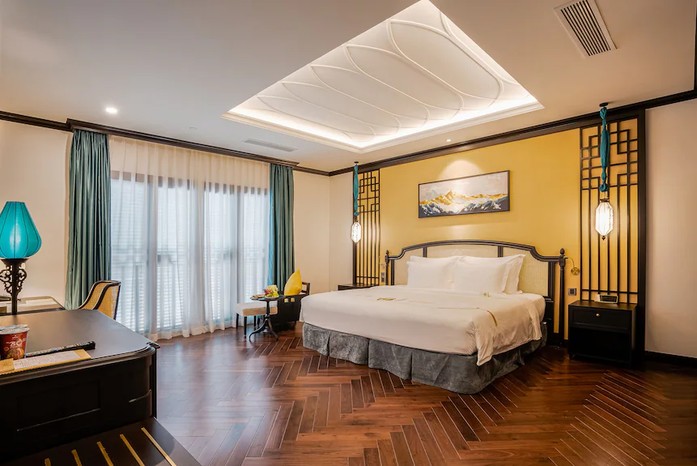
Nha Trang is a beautiful coastal city and boasts many luxury resorts and hotels. We stayed at the 5-Star Potique Hotel in downtown Nha Trang.
You can book the Potique Hotel or any hotel in Nha Trang, or anywhere in Vietnam, right here through any of the below options, at the location of your choice here – TripAdvisor or Hotels.com or HotelsCombined and save a lot by getting the best deals on booking your stay.
| Click to book the best hotel in Nha Trang or Best Hotels in Vietnam |
|---|
Po Nagar Temple FAQ
What is the dress code for Po Nagar Temple?
Ponagar Tower Dress Code mandates conservative dressing, you should wear dresses that reach below the knee and avoid revealing clothes, as it is a place of worship.
Why are there Hindu temples in Vietnam?
In the medieval period, the Champa Empire, which was a Hindu empire, extended across parts of central Vietnam and stretched into Cambodia. The Hindu influence on the religion and culture of Vietnam can be seen in the many ancient Hindu temples of Vietnam.
How old is Ponagar Tower?
The Ponagar Tower in Nha Trang is at least 1200 years old, though the date of its origin is not known.
Are jeans allowed in the temple?
Yes, full-length jeans can be worn in the temple.
What are the top 3 religions in Vietnam?
The main religions followed in Vietnam are Buddhism, Taoism, and Confucianism.
We left the precincts of the Po Nagar Temple Complex, feeling enriched and also proud of the religious and cultural influence of India that extended across South-East Asia. The ancient Cham temple stands as an enduring ode to the tenets of Hinduism in a distant land, across the seas. We hope you found our post about the Ponagar temple of Nha Trang interesting. Do make sure to subscribe to our blog and newsletter for more such content. Connect with us on our social media channels, too.
Step Into a World of Stories – Travel With Us!
Do you long for breathtaking views, unforgettable moments, and stories that stay with you forever? Come along as we journey through vibrant cultures, uncover lesser-known gems, and share soulful tales that spark your travel dreams.
Discover the magic of exploration on our YouTube channel – Travel With Sandy & Vyjay. Each video invites you into a new corner of the world, with stunning visuals, cultural insights, and practical tips to inspire your next trip.
Craving your daily dose of travel inspiration? Follow us on Instagram, Facebook, X (Twitter), LinkedIn, and YouTube for a vibrant stream of photos, destination ideas, and real-time travel snippets.
Want a little wanderlust delivered straight to you? Subscribe to our Voyager Travel Bytes and receive thoughtfully curated travel inspiration via email or WhatsApp. Want to see our travels in action? Instagram is where the magic unfolds in real-time!
Let’s Co-Create Your Next Big Adventure
Whether your heart beats for daring escapades, tranquil hideaways, cultural immersion, or spiritual journeys, we are here to turn your travel vision into an extraordinary reality, crafted just for you.
Turn Your Travel Dream Into a Journey Worth Remembering
Have a dream destination or need help deciding where to go next? Drop us an email at imvoyager18@gmail.com — we will design an itinerary that reflects your style, pace, and passions.
There is a whole world waiting to meet you. Shall we explore it together?
We are a reader-supported site. This means, at no additional cost to you, we may earn a small commission if you book a flight or hotel, or make a purchase through one of our affiliate links. Thank you for your support!
Flights – Air India (Domestic) or Air India (International), or Priceline
Tours – Click to book top tours around the world. Book tours and activities here.
Experiences – Book your next unforgettable experience here, with flexible bookings and free cancellations. Reserve tours and activities now and pay later.
Hotels – Click to book the best hotels/resorts. Choose the best stay options with TripAdvisor or Hotels.com, or HotelsCombined
Travel Insurance – Click to book Travel Insurance that covers a range of travel insurance and safety services including medical emergencies, lost luggage, trip cancellation and more
Visas and Travel Documents Application – Click here for Online Travel Visa Check
Online Passport Photo – Get Your Passport Photo Online here
Do You Love Traveling?
Do you want to know how to travel the world? We have put together a very useful travel resources page with the best travel tips. Go check it out now. Thanks for visiting our site Voyager - imvoyager.com and taking the time to read this post! If you wish to collaborate/work with us then reach us at imvoyager18@gmail.com We’d love it if you’d comment by sharing your thoughts on this post and share this post on social media and with your friends. Follow our journey on our social media channels: Facebook X Instagram Pinterest YouTube
Start dreaming about your next adventure with Tripadvisor. Book your next unforgettable experience here with flexible bookings and free cancellations.
Flight booking online at the best fare
60+ Million Users Trust TripAdvisor With Their Travel Plans. Shouldn't You?
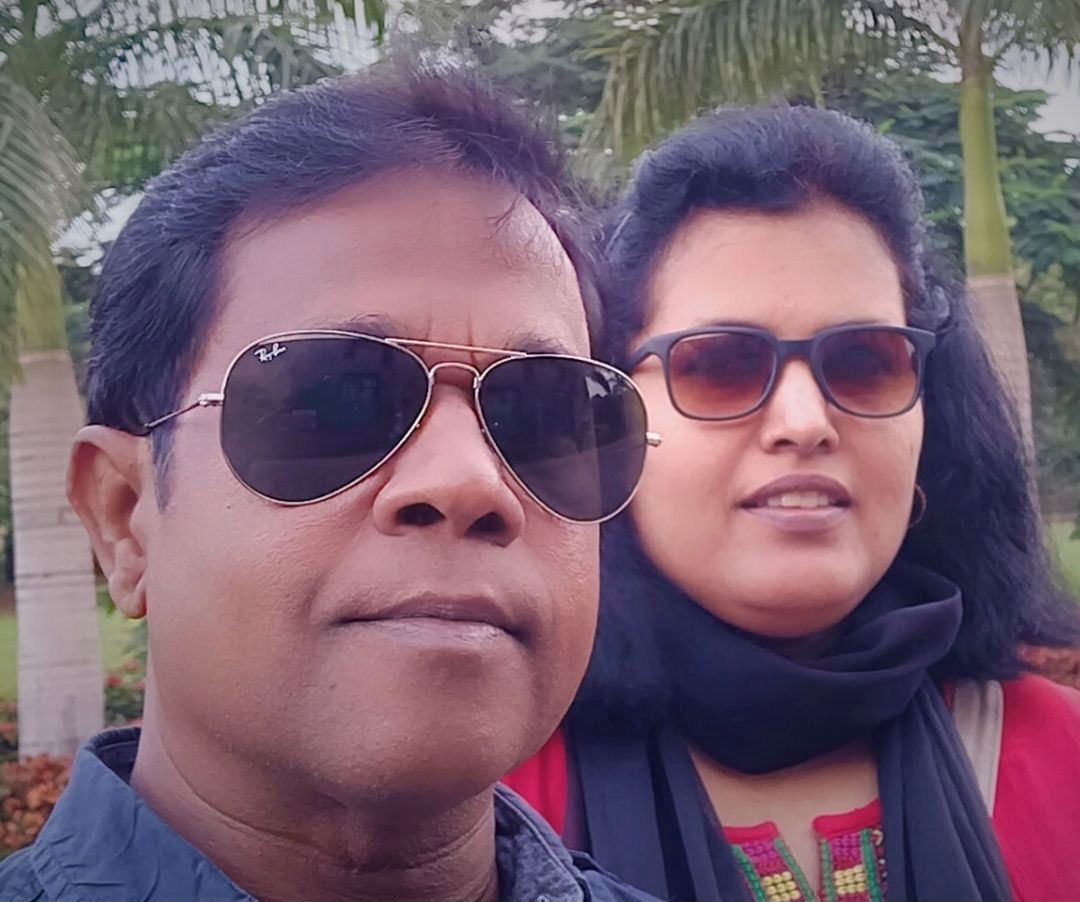
Sandy & Vyjay are a husband and wife duo who are travel content creators. They are co-founders of this travel website and are one of the leading travel content creators in India.
Sandy & Vyjay quit their successful corporate careers to pursue their passion for travel and writing full-time. Their dedication has earned them the “Best Travel Writer” award and numerous accolades on both national and international stages. Focusing on India’s destinations, heritage, and culture, they are passionate advocates for nature and the environment. Through their content, they promote ecotourism and sustainable travel, inspiring others to explore and preserve the beauty of India.
